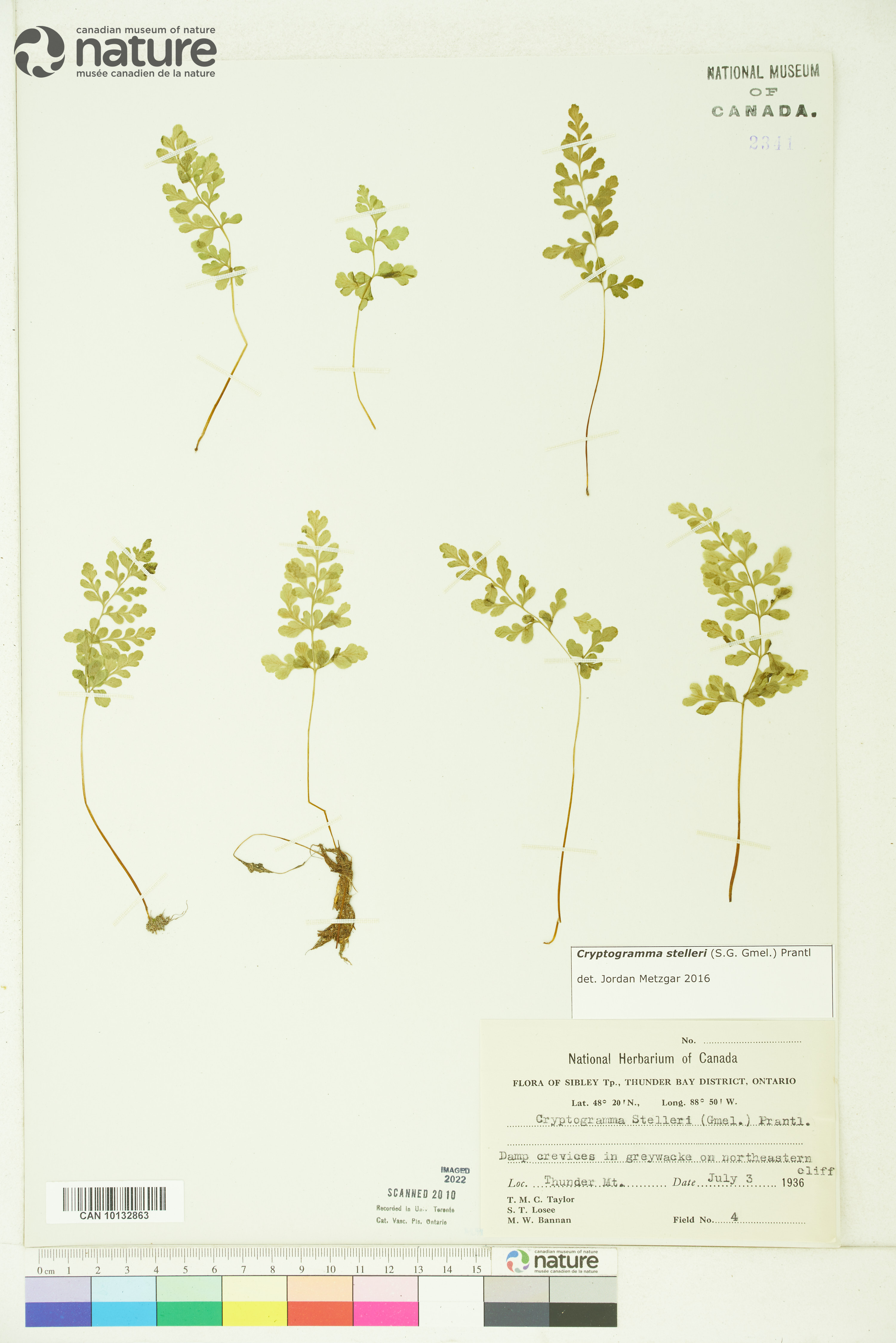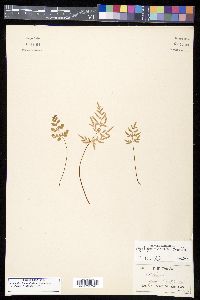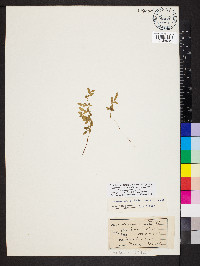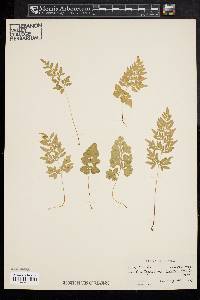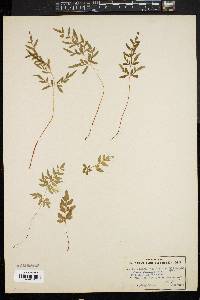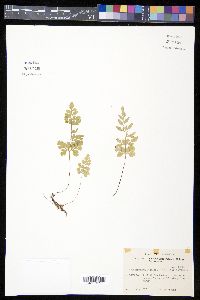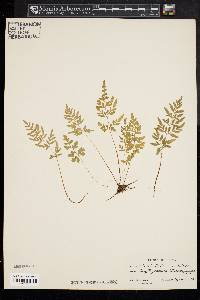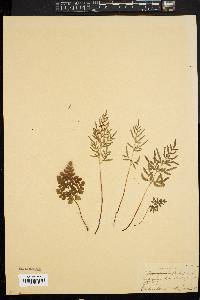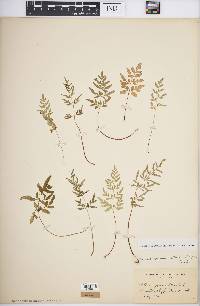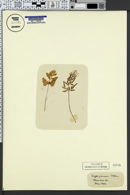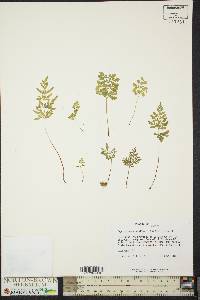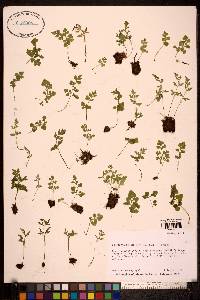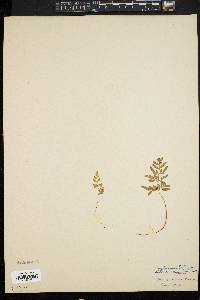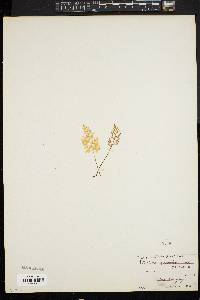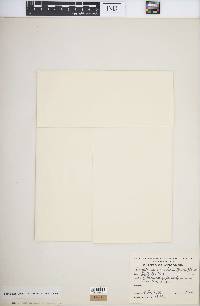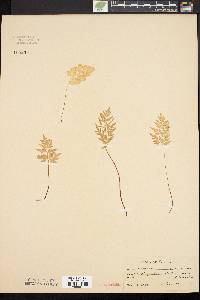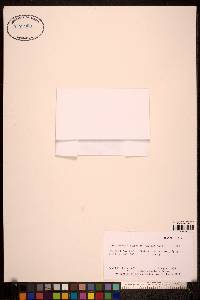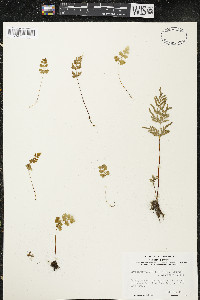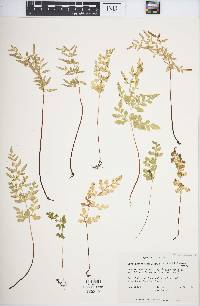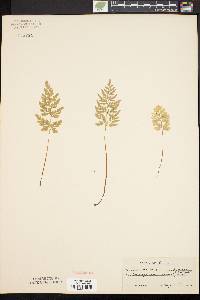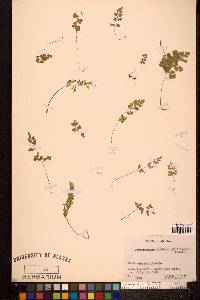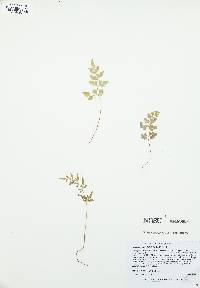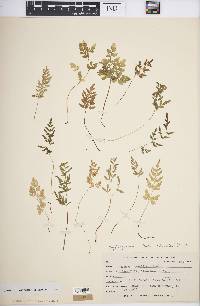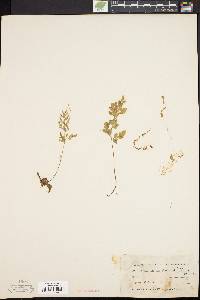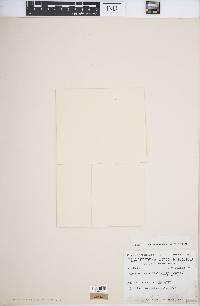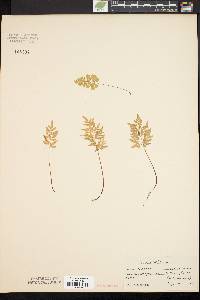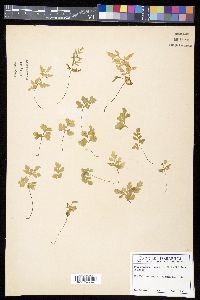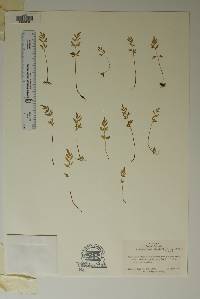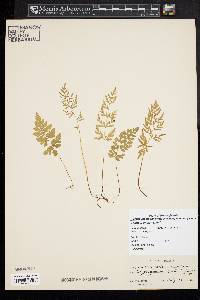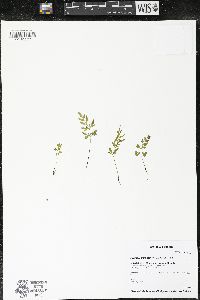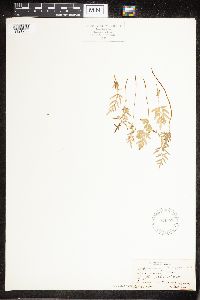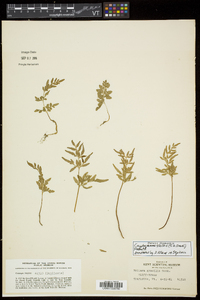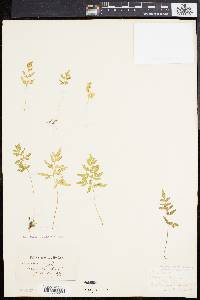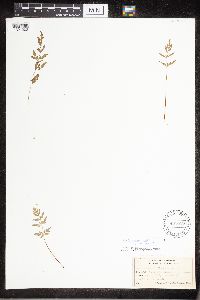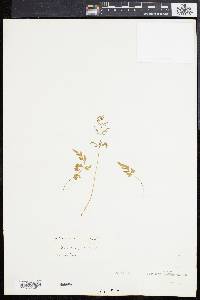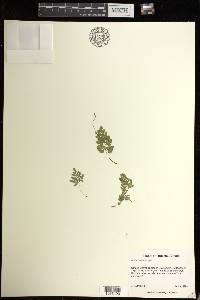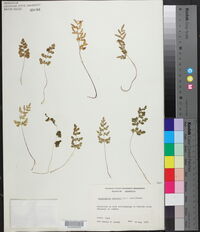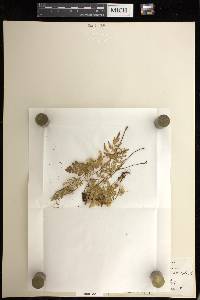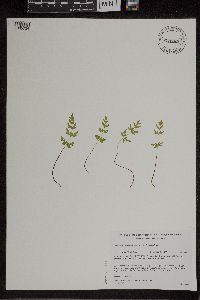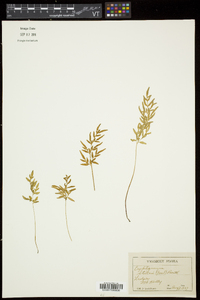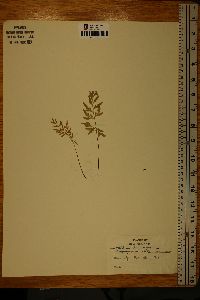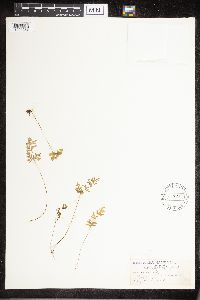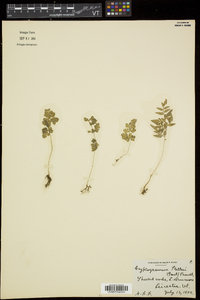Cryptogramma stelleri
|
|
|
|
Family: Pteridaceae
Fragile Rockbrake
[Allosorus gracilis (Michx.) Farw., moreCryptogramma gracilis (Michx.) Clute, Pellaea gracilis , Pellaea stelleri (S. G. Gmel.) Baker] |
Stems creeping, few branched, slender, 1--1.5 mm diam., succulent, brittle; scales colorless, sparse, transparent-reticulate, ovate, 0.4 × 0.3 mm; stems shriveling in 2d year following emergence of leaves. Leaves scattered along stems, ephemeral (dying by late summer), soon shed; sterile leaves erect, 3--15 cm; fertile leaves erect, 5--20 cm; petioles, costae, and costules glabrous. Petiole dark brown in proximal 1/2 or less, becoming greenish distally, ca. 1 mm wide when dry, only slightly furrowed, glabrous. Blade broadly lanceolate to ovate-lanceolate, all pinnate-pinnatifid to 2-pinnate, herbaceous to membranous, thin; hydathodes superficial, often poorly developed or absent. Segments of sterile leaves ovate-lanceolate to fan-shaped, distal 1/2--1/3 shallowly lobed; segments of fertile leaves horizontal to ascending, often only partially differentiated from sterile leaves, lanceolate to linear, 8--25 × 2--4 mm; margins reflexed, forming continuous false indusia. Sporangia often in discrete sori. 2 n = 60. New growth produced in spring, dying by late summer. Sheltered calcareous cliff crevices and rock ledges, typically in coniferous forest or other boreal habitats; 0--3000 m; Alta., B.C., N.B., Nfld., N.W.T., N.S., Ont., P.E.I., Que., Yukon; Alaska, Colo., Conn., Ill., Iowa, Maine, Mass., Mich., Minn., Mont., Nev., N.H., N.J., N.Y., Oreg., Pa., Utah, Vt., Wash., W.Va., Wis., Wyo.; Europe in ne former Soviet republics; Asia. Perennial fern 3 - 25 cm tall Leaves: several, scattered along rhizome, stalked, very thin and soft, hairless, 3 - 20 cm long, lance-shaped to narrowly egg-shaped in outline, but pinnately compound with central "midrib" (rachis) green or straw-colored. The leaf divisions (pinnae) are pinnately-lobed or sometimes further pinnately divided. Both sterile and fertile leaves produced, but both dying back and shed by late summer. Rhizome: creeping with a few branches, succulent, brittle, slender (1 - 1.5 mm diameter), with sparse, colorless, somewhat veiny, 0.4 mm long, 0.3 mm wide, egg-shaped scales. The rhizomes shrivel up in the second year after the leaves emerge. Leaf stalks: scattered along rhizome, erect, 2.5 - 15 cm long, hairless, greenish though dark brown near base. Spores: 64 per sac, usually yellow when mature, all of one kind, three-sectioned (trilete), somewhat four-angled, and warty. The spores are released in the spring, and give rise to the gametophyte (the sexual phase of the plant), which is small, green, inversely heart-shaped to kidney-shaped, hairless, and sits above the ground. Sterile leaves: erect, stalked, green, shorter than fertile leaves (3 - 8 cm long), 2 - 5 cm wide, lance- to egg-shaped in outline, but pinnately divided. The leaf divisions (pinnae) are 0.5 - 1.5 cm long, 0.3 - 1 cm wide, egg- to fan-shaped or rounded, and either further pinnately divided or lobed, but they are only shallowly lobed in the upper half or third. Fertile leaves: erect, stalked, green, longer than sterile leaves (5 - 15 cm long), lance- to egg-shaped in outline, but pinnately divided. The leaf divisions (pinnae) are 0.8- 2.5 cm long, 2 - 4 mm wide, and sometimes quite similar to those of the sterile leaves, but usually they are more lance-shaped to linear in outline, and the edges are reflexed and somewhat transparent and papery. Similar species: Cryptogramma stelleri may be confused with Pellaea glabella, but that species has a distinctly dark brown leaf stalk and central rachis, and all the leaves are fully pinnately compound two times with the final segments (pinnules) all somewhat oblong. Habitat and ecology: Incredibly rare, possibly close to extinction in the Chicago Region, requiring limestone rock faces, cliffs, or outcrops. Occurence in the Chicago region: native Notes: This species just reaches south into the western part of the Chicago Region. It has a much more northern range, typically occurring in conifer forests or other boreal habitats to our north. Oddly, it has never been observed in the lower pennisula of Michigan even though it reaches around the west side of Lake Michigan throughout Wisconsin and into very northern Illinois. Etymology: Cryptogramma comes from the Greek words cryptos, meaning hidden, and gramme, meaning line, referring to the leaf edges that inroll and hide the lines of clusters of spore sacs. Stelleri is named after its discoverer, Georg Wilhelm Steller (1709 - 1746). Author: The Field Museum Rhizomes slender, soft, creeping, pilose and scaly, the pale brown, hyaline-reticulate scales not over 2 נ0.5 mm; lvs scattered, thin and soft, deciduous; petioles castaneous or dark purple basally, usually greenish or stramineous distally, 2.5-15 cm, the fertile ones commonly longer than the sterile; sterile blades 3-8 נ2-5 cm, 2-3 times pinnate with confluent, flabellate to ovate, distally toothed pinnules 5-15 נ3-10 mm; fertile blades with longer and narrower, sometimes linear pinnules to 2 cm נ3(-5) mm, the rather narrowly reflexed, evidently hyaline-scarious indusial margin more strongly modified than in C. crispa; 2n=60. Calcareous rocks and moist shady slopes, circumboreal, in Amer. from Nf. to Alas., s. to n. N.J. (formerly), n. Pa., W.Va., Ill., Io., Utah, and Wash. Gleason, Henry A. & Cronquist, Arthur J. 1991. Manual of vascular plants of northeastern United States and adjacent Canada. lxxv + 910 pp. ©The New York Botanical Garden. All rights reserved. Used by permission. |

